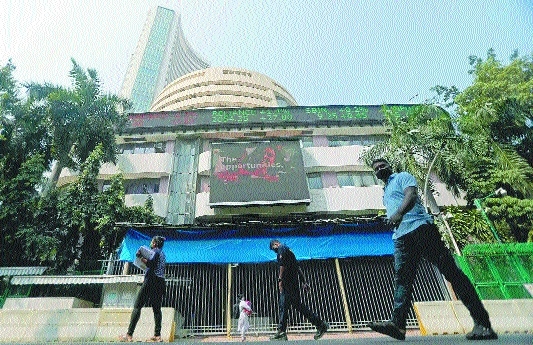India is ready to bet on risks
| Date :03-Oct-2021 |

By Rahul Dixit :
Message From The Market:

THE amazing bull run the BSE Sensex had last week to soar past the 60,000+ mark was a clear indication of India’s resolve to go for the risks despite conflicting global cues. Amid lurking fears of another slowdown triggered by the debt default by Chinese real estate giant Evergrande, investors shrugged all the cues aside and decided to bet on India. Defiant on emerging out of the COVID-19 shadow India is simply not ready to get bogged down. The prime factor behind the continuing resurgence of markets and subsequently the indices is the belief investors have found in the ‘India Growth Story 2030’. The last 18 months reflect the same, during which the benchmark indices took a massive 131 per cent leap to cross the 60,000-mark after reaching the bottom of 25,982 in March 2020. The last run of 10,000 points after touching 50,000-mark in January this year proves that India is surely emerging as a world leader during the COVID-19 period and holds tremendous growth potential. The record rally can be attributed to the inherent nature of stock markets being forward-looking. Foreign Institutional Investors (FIIs) and Foreign Portfolio Investors (FPIs) have understood the earnings potential in Indian companies that will be driven by the spending potential of Indian consumers.
That is so because one man’s expense is another man’s income. The FPI had seen a slowdown in the last few months on cues of protectionist policies being implemented by the United States during the peak of second wave of the coronavirus. However, the clouds seem to have dispersed sooner than expected. The same strength has now been shown by Domestic Institutional Investors (DIIs). Yet, investors should be careful in not getting carried away and instead put their hard-earned money in investment products that they understand have the patience to hold in the long term, because there definitely will be some corrections along the way. But in the long term, just like the Indian cricket team, equity markets are going to get stronger. According to Jinay Savla, Partner at Indigenous Investors, Mumbai, going ahead, as a thought the investors should ask some simple questions like, “Will the leading paint company continue to deliver promising results going forward or is it just a one-time thing? Will the leading family of India continue to grow at the same pace like it did in lockdown? Should you take your chances on smaller companies who appear to be cheap? These are just a few basic queries before deciding to place bets on the growing market. Investors should get a drift that it’s important to ask the right questions based on this record rally rather than simply putting their hard-earned money into equity markets.” Sensex always rewards the winners. So it is important to have more winners in the top tier. At present, out of the 30 companies in the BSE Sensex, top six account for almost 52% weightage. Banks dominate 26 per cent of the companies but banking has negligible contribution to the index. Agriculture, manufacturing and travel which make a high contribution to the overall economy have very low contribution in Sensex. All these factors need to be taken into consideration by the investors. The current rally and bullish future also makes it incumbent upon the Indian business houses to sustain the momentum as the trajectory will remain positive on the continuous cycle of production and supply. Also, the next phase must see serious contributions from sectors like Realty and Banking.
Both have received infusion of funds via Centre’s relief packages and now must work on the positive trend to get their house in order. Banks have a few hurdles in their way like dealing with the burgeoning Non-Performing Assets (NPAs). A report by Assocham and Crisil has indicated that the gross NPAs of commercial banks are likely to cross Rs 10 lakh crore by March 2022. Though the Government’s announced creation of a Bad Bank that will acquire bad debts from several banks, the challenge would be to find prospective buyers for the stressed assets. Then there is the challenge of providing impetus to credit off-take which, at present, is below six per cent. It indicates reluctance of existing factories in availing loans for capacity expansion. Effective management of such hiccups holds the key for future good run. Though indices don’t often show the full picture, they do hold up a mirror to the changing reality. An important consideration cannot be left untouched at this stage when the Indian economy finds itself perched on the cusp of a cultural shift. For decades, it has seen its operations being handled in a sluggish manner, thanks mainly to the over-infusion of emergency funds into the system. It often showed an untoward reliance on mouth-to-mouth breathing by the State to keep its act going.
The same approach has been taken even now by the Government, naturally because of the impossibility of the situation. But this is also the exact reason of the cultural sluggishness that has often dogged the national economy. Even though the current infusion of funds into the system may sound good on the surface, a dangerous possibility often lurks beneath that these funds will act mostly as a stage two of a rocket that may not hold on to its upward trajectory -- if enough gist is not added by way of entrepreneurial approach. In other words, the national economy is hungering for greater enterprise on all counts. Though general signs are good, enterprise may still be eluding the expected action. This is the cultural lag that must be dealt with on an immediate basis, if we have to maximise gains of the current push.